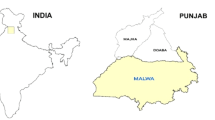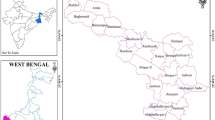Abstract
In this paper, groundwater aquifer vulnerability map has been developed by incorporating the major geological and hydro-geological factors that affect and control the groundwater contamination using GIS based DRASTIC model. This work demonstrates the potential of GIS to derive a map by overlying various spatially referenced digital data layers that portrays cumulative aquifer sensitivity ratings across the Kathmandu Valley, Nepal, providing a relative indication of groundwater vulnerability to contamination. In fact, the groundwater is the major natural resources in Kathmandu for drinking purpose. The decline in groundwater levels due to the over exploitation and thus extracted water from shallow aquifer has been contaminated by the infiltration of pollutants from polluted river and land surface is continuous and serious. As the demand for water for human and industrial use has escalated and at the same time, the engineering and environmental costs are much higher for new water supplies than maintaining the existing sources already in use. Management of groundwater source and protecting its quality is therefore essential to increase efficient use of existing water supplies. Aquifer vulnerability maps developed in this study are valuable tools for environmental planning and predictive groundwater management. Further, a sensitivity analysis has been performed to evaluate the influence of single parameters on aquifer vulnerability assessment such that some subjectivity can be reduced to some extent and then new weights have been computed for each DRASTIC parameters.










Similar content being viewed by others
References
Aller L, Bennet T, Lehr HJ, Petty JR, Hackett G (1987) DRASTIC; a standardized system for evaluating groundwater pollution potential using hydrogeologic settings: EPA-600/2-87-035, pp 622
British Geological Survey (2001) Groundwater quality: Nepal, Natural Environmental Research Council, British Geological Society
Department of Hydrology and Metrology (DHM) (2005) Precipitation and evaporation records of the Bagmati zone (1999–2005). Ministry of Environment, Science and Technology, Government of Nepal, Babar Mahal, Kathmandu, Nepal
Dixit A, Upadhaya M (2005) Augmenting groundwater in Kathmandu Valley; challenges and possibilities. Nepal water conservation foundation, Kathmandu, Nepal
Doerfliger N, Zwahlen F (1997) EPIK: a new method for outling of protection areas in karstic environment. In: International symposium on karst waters and environmental impacts, pp 117–123
El-Naqa A (2004) Aquifer vulnerability assessment using the DRASTIC model at Russeifa landfill, northeast Jordan. J Environ Geol 47(1):51–62
Gautam R, Rao GK (1991) Groundwater resources evaluation of the Kathmandu Valley. J Nepal Geol Soc 7:39–48
Gogu RC, Dassargues A (2000) Sensitivity analysis for the EPIK method of vulnerability assessment in a small karstic aquifer, Southern Belgium. Hydrogeol J 8(3):337–345
Hamerlinck JD, Ameson CS (eds) (1998) Wyoming Groundwater vulnerability assessment handbook, vol I. University of Wyoming, SDVC Report 98-01-1, pp 31–62
Kathmandu Valley GIS database (2000) Towards bridging the data gap, MENRIS/ICIMOD
Khadka MS (1993) Groundwater quality situation in alluvial aquifers of the Kathmandu Valley, AGSO. J Aust Geol Geophys 14:207–211
Lodwik WA, Monson W, Svoboda L (1990) Attribute error and sensitivity analysis of maps operation in geographical information systems–suitability analysis. Int J Geograph Inf Syst 4:413–428
Merchant JW (1994) GIS-based groundwater Pollution hazard assessment a critical review of the DRASTIC model. Photogrammetry Eng Remote Sensing 60(9):1117–1127
Napolitano P, Fabbri AG (1996) Single parameter sensitivity analysis for aquifer vulnerability assessment using DRASTIC and SINTACS. In: Proceedings of the 2nd HydroGIS conference, vol 235. IAHS Publication, Wallingford, pp 559–566
National Geographic Information Infrastructure Project (NGIIP) (1994) Department of Survey, Government of Nepal, Kathmandu, Nepal
National Research Council (1993) Groundwater vulnerability assessment: Contamination potential under conditions of uncertainty, National Academy Press, Washington, DC
Piscopo G (2001) Groundwater vulnerability map explanatory notes, Lachlan Catchment, Centre of Natural Resources, New South Wales (NSW) Department of Land and Water Conservation, pp 14
Ramos-Leal JA, Rodríguez-Castillo R (2003) Aquifer vulnerability mapping in the Turbio river valley, Mexico, a validation study. Geofísica Int 42(1):141–156
Shrestha OM, Koirala A, Karmacharya SL, Pradhananga UB, Pradhan PM, Karmacharya R, Hanisch J, Kerntke M, Joshi PR, Steiner L, Busch K, Jnwali BM, Maske ND, Tuladhar GB, Kaphle KP (1998) Engineering and environmental geological map of Kathmandu Valley, scale 1:50,000. Department of Mines and Geology, Nepal
Shrestha OM, Koirala A, Hanisch J, Busch K, Kerntke M, Jager S (1999) A geo-environmental map for the sustainable development of the Kathmandu Valley, Nepal. Geo-journal 49:165–172
Vrba J, Zaporozec A (1994) Guidebook on mapping groundwater vulnerability, international contributions to hydrology, vol 16. Heinz Heise, Hannover, pp 131
Zhang R, Hamerlinck JD, Gloss SP, Munn L (1996) Determination of nonpoint-source pollution using GIS and numerical models. J Environ Qual 25(3):411–418
Acknowledgments
The first author gratefully acknowledges the Osaka Sangyo University for its support during the completion of this work. This study was supported by Japanese Government (MONBUKAGAKUSHO:MEXT) scholarship to the first author. Constructive suggestions and comments on the manuscript from the reviewer(s) and editor(s) are very much appreciated.
Author information
Authors and Affiliations
Corresponding author
Rights and permissions
About this article
Cite this article
Pathak, D.R., Hiratsuka, A., Awata, I. et al. Groundwater vulnerability assessment in shallow aquifer of Kathmandu Valley using GIS-based DRASTIC model. Environ Geol 57, 1569–1578 (2009). https://doi.org/10.1007/s00254-008-1432-8
Received:
Accepted:
Published:
Issue Date:
DOI: https://doi.org/10.1007/s00254-008-1432-8




